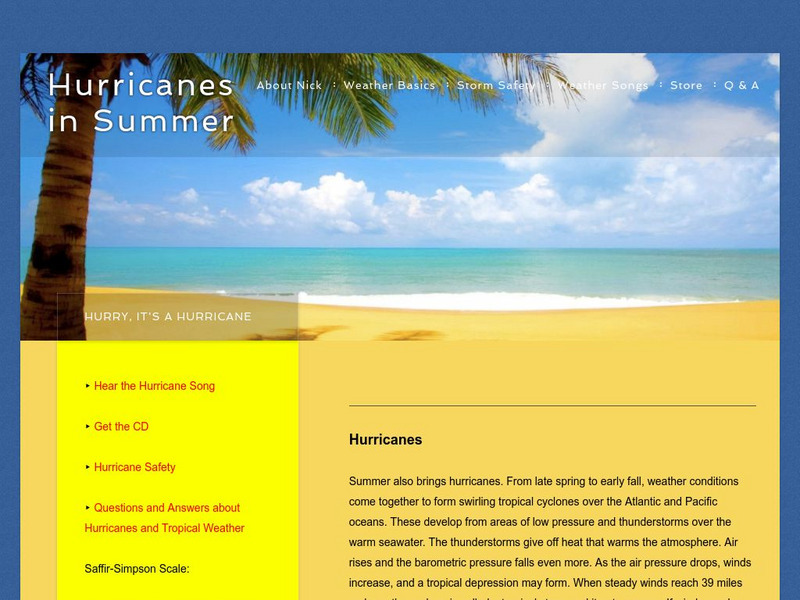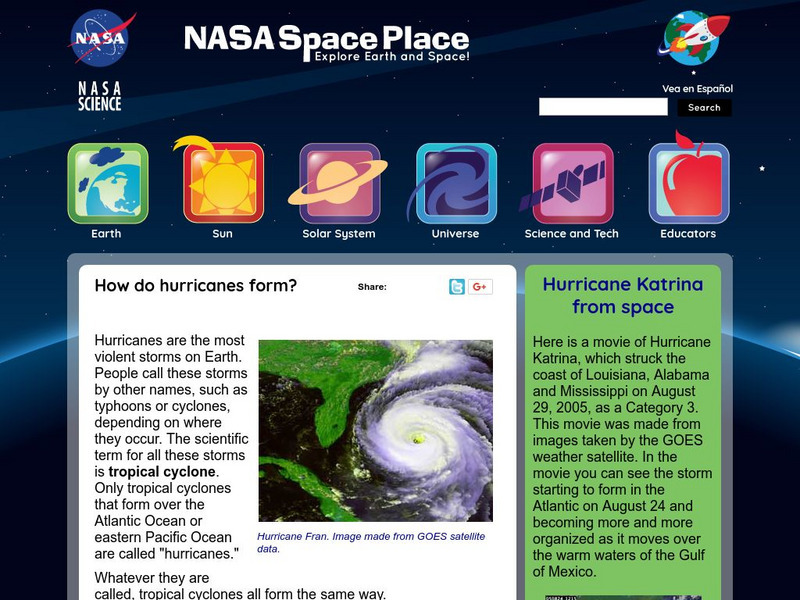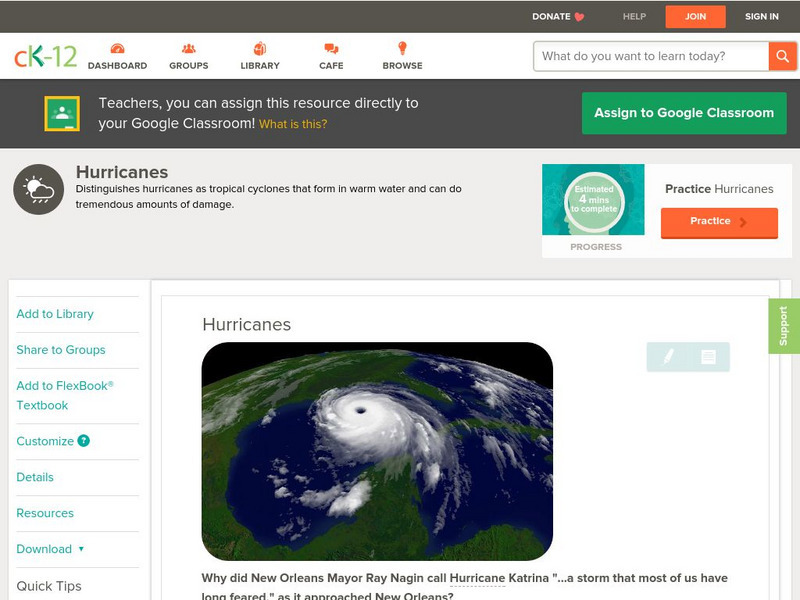University of Illinois
University of Illinois Urbana Champaign: How Hurricanes Are Named
An explanation of how hurricanes are named. They rotate in alphabetical order between male and female names. There are names for the Atlantic and Eastern Pacific from 1999 - 2004. Fascinating!
Science Education Resource Center at Carleton College
Serc: Introduction to Texas Hurricanes
In this activity, young scholars are asked to graph data about some 20th century hurricanes that hit the Texas coastline. For each graph, they are asked several questions about any apparent correlation between the different variables....
PBS
Pbs: American Experience: The Hurricane of '38
Experience the devastating Hurricane of 1938 that roared up the east coast with survivor interviews, photos, and video clips. Includes an explanation of hurricane formation.
Extreme Science
Extreme Science: Hurricanes
Whether you know it as hurricanes, typhoons, or cyclones, these dangerous storms are described in this article.
Dan Satterfield
Dan's Wild Weather Page: Hurricanes
Use this site to find out about hurricanes and how to track them.
Other
Internet Geography: Weather and Climate, Tropical Storms
Description of tropical storms and links to several case studies. This site includes information, such as how tropical storms are named, how they occur, and how they are structured.
Other
Hurricane Archive: Preserving the Stories of Katrina, Rita, and Wilma
Resource holds a wealth of stories, photographs, and maps that document periods of devastation resulting from hurricane Katrina, Rita, and Wilma. Numerous other features contribute to making this site an extremely well rounded,...
Other
Kidstorm: Hurricanes
Get the facts on hurricanes with this detailed information page. This page includes photos, charts and satellite images.
NASA
The Earth Sun System
This resource provides some interesting video footage of the Sun. Also included is information about the effects of solar radiation on the Earth's magnetosphere and weather.
US Geological Survey
Usgs: Natural Hazards Programs: Lessons Learned for Reducing Risk [Pdf]
This site provides links to articles about natural disasters such as volcanoes, earthquakes, landslides, floods, etc.
eSchool Today
E School Today: Your Cool Facts and Tips on Hurricanes
Do you know what was the most destructive hurricane? Provides an explanation of a hurricane while exploring how they form, how they are measured and classified, effects, and how they get their names.
NOAA
Noaa: National Hurricane Center: The Saffir Simpson Hurricane Scale
Read how hurricanes are rated on the Saffir-Simpson scale and check out the hurricane record for each level of the scale.
NOAA
Noaa: Nhc:deadliest Atlantic Tropical Cyclones, 1492 Present
The National Hurricane Center site contains a large body of information on hurricanes. From this site find out what a storm surge is, when the first record of a tropical storm was made. Go to the home page and find the latest forecasts.
Scholastic
Scholastic: Study Jams! Science: Weather & Climate: Severe Storms
A slideshow and a short multiple-choice quiz on the topic of severe storms, some types, and the damage that they cause.
CNN
Cnn: What Made Hurricane Matthew So Unique?
Many photos capture the impact of this long and strong storm, but what made this storm different from others? Find out.
National Geographic
National Geographic: Extreme Weather on Our Planet
This lesson from National Geographic for grades 2-5 has a great photo gallery and video of extreme weather, and a chart for plotting weather investigation. Learning objectives, teaching methods, and connections to National Science...
Curated OER
Weather Dude: Hurricanes
Informational weather site allows users to learn more about these swirling tropical cyclones. Discover how they are formed and named as well as learn some interesting facts about them along the way.
Science Education Resource Center at Carleton College
Serc: Hurricanes
Nine learning modules for young scholars to study hurricanes using satellite imagery and visualizations, and participate in some hands-on experiments. They'll also explore over 150 years of storm data to find out when and where these...
NASA
Nasa: Hurricanes
Learn about hurricanes and how they are created. Features include video animation, the histories of the most devastating hurricanes and topics such as hurricane naming and hurricane study.
NASA
Nasa: The Space Place: How Do Hurricanes Form?
This resource explores how hurricanes form and why they are called tropical cyclones. Images and illustrations are provided supporting this information.
University of Wisconsin
The Why Files: Hurricanes
Learn about what it takes to be a hurricane and how hurricane tracking has improved over the years.
US Environmental Protection Agency
Epa: Natural Disasters: Hurricanes
See some real-world issues as well as the scientific research and technology used to support the EPA's mission to protect human health and safeguard the natural environment.
CK-12 Foundation
Ck 12: Earth Science: Hurricanes
[Free Registration/Login may be required to access all resource tools.] Describes how a hurricane forms and its effects.



















